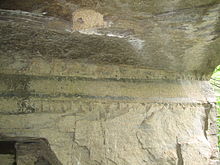Sitovo inscription


The Sitovo inscription is an inscription that has yet to be satisfactorily translated. It was discovered in 1928 by an archaeological expedition led by on the wall of a rock shelter near the village of Sitovo, close to Plovdiv, Bulgaria. In 1943 Peev, an active anti-fascist, was executed by firing squad on suspicion of sending a coded message to the Soviet Union, after he sent an example of the text to Soviet archaeologists, in the hope that they could decipher its meaning.[1][2] The inscription was published in 1950 by .
Characteristics[]
The inscription is in two lines which are 3.40 metres (11.2 ft) long. The written signs are 40 centimetres (16 in) tall.
Possible translations[]
Various attempts by both amateurs and professionals to translate it have been made. It has been variously identified as local ancient language, Celtic, Slavic, and Phrygian.[3]
See also[]
References[]
- ^ "Alexander Peev (1886-1943) and the Ancient Sitovo Script". thesanghakommune.org. 26 February 2017.
- ^ Moss, Candida (6 August 2017). "Inside the Deadly Pursuit of Unsolved Languages" – via www.thedailybeast.com.
- ^ Mel Copeland. "Translation of the Phrygian language".
The second inscription is a rock-text near Sitovo village at 30 km south-east of Plovdiv in the Rhodopes Range. After their own autopsia Bayun-Orel 1991, 144-148, dated the inscription in III-I c. B.C. and saw on the rock "Ipta" as "figurine, cult object, image (in paredria?) with Bacchus' figurine."
[sic]
- Prehistoric Bulgaria
- Tourist attractions in Plovdiv Province
- Rhodope Mountains
- Inscriptions in undeciphered writing systems